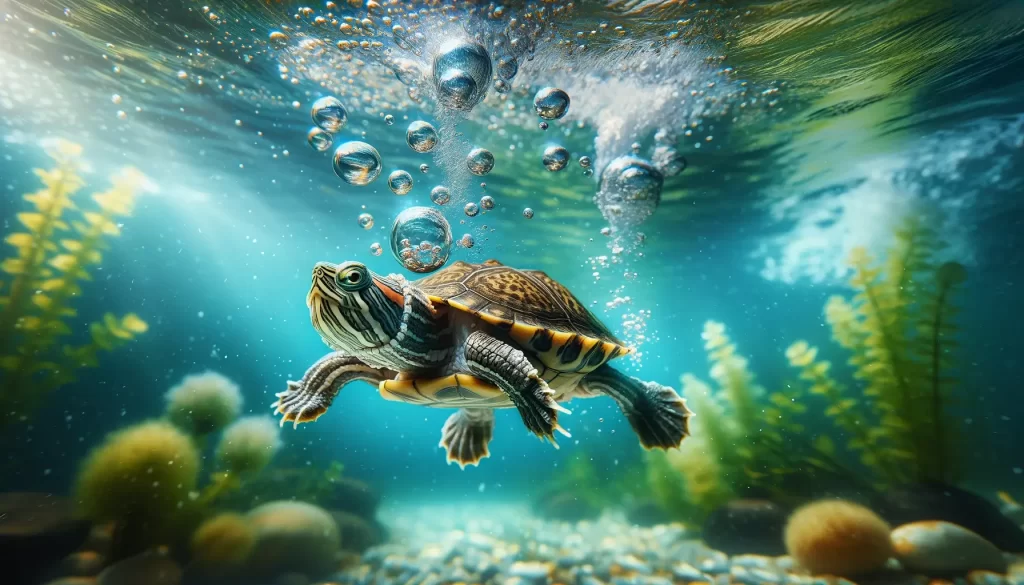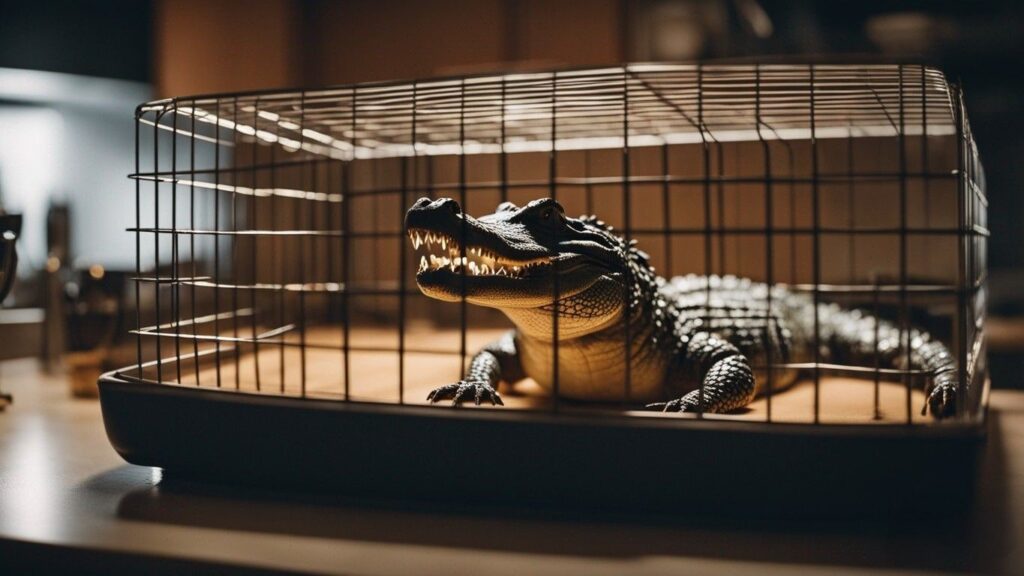
Imagine having a pet turtle and wondering if it can survive beneath the water’s surface. It’s a fascinating question that many turtle owners have pondered.
In this article, we will explore the intriguing world of pet turtles and their ability to breathe underwater.
You’ll discover the surprising truth about turtles’ respiratory system and whether they possess the extraordinary capability to live and thrive underwater.
Get ready to delve into the mysterious aquatic realm of these enchanting creatures.
Can Pet Turtles Breathe Underwater
Have you ever wondered if pet turtles can breathe underwater? It’s a fascinating question, and one that many turtle owners may ponder.
Shell Adaptation for Aquatic Respiration
Structural Characteristics of the Turtle Shell
The turtle shell is a unique feature that sets turtles apart from other reptiles. It consists of two main components: the carapace (the upper shell) and the plastron (the lower shell).
The shell provides vital protection for the turtle’s internal organs, but it also plays a role in supporting aquatic respiration.
Importance of Shell Design for Aquatic Respiration
The streamlined shape of the turtle shell allows for efficient movement through water. This is crucial for turtles that spend a significant amount of time in aquatic environments.
The shell’s design minimizes drag and allows turtles to swim effortlessly, facilitating their ability to submerge and breathe underwater.
Breathing Mechanism of Pet Turtles
Overview of Turtle Respiration
Turtle respiration involves the intake of oxygen and the release of carbon dioxide. Like other reptiles, turtles rely on lungs for respiration.
However, unlike mammals, turtles do not have a diaphragm to help with the breathing process. Instead, they utilize different mechanisms to facilitate respiration.
Pulmonary Ventilation
When turtles breathe, they rely on a process known as pulmonary ventilation. This involves the contraction of muscles surrounding the lungs, which allows for the expansion and contraction of the chest cavity.
As the chest cavity expands, air is drawn into the lungs, and when it contracts, the air is expelled.
Gas Exchange in Turtles
Once air is drawn into the turtle’s lungs, gas exchange occurs. Oxygen from the air diffuses into the turtle’s bloodstream, while carbon dioxide moves out of the bloodstream and into the lungs to be exhaled.
This gas exchange process ensures that the turtle receives the oxygen it needs to survive.
Role of Residual Air Spaces
Turtles have a unique adaptation that aids in gas exchange during periods of submergence. They possess specialized air sacs located within their bodies, known as residual air spaces.
These air sacs serve as temporary oxygen stores, allowing turtles to continue metabolizing oxygen even when they are unable to access fresh air.
Behavior and Adaptation to Underwater Environments
Dive Behavior in Pet Turtles
Pet turtles exhibit various behaviors that enable them to adapt to underwater environments. They are capable of taking prolonged dives, often staying submerged for extended periods of time.
These diving behaviors are influenced by a combination of factors, including oxygen availability, temperature, and the turtle’s metabolic rate.
Oxygen Storage Adaptations in Turtles
Turtles have evolved several adaptations to facilitate their ability to store oxygen during dives.
One such adaptation is the ability to reduce their metabolic rate, which helps conserve oxygen and prolong their time underwater.
Additionally, the presence of residual air spaces within the turtle’s body allows for the storage of oxygen for later use.
Behavioral Adaptations for Extended Submergence
To maximize their time underwater, turtles may exhibit certain behavioral adaptations. They may slow down their movements and conserve energy, reducing the need for oxygen.
Some species of turtles are also capable of absorbing oxygen through their skin while submerged, further extending their ability to stay underwater for extended periods.
Impact of Temperature on Underwater Respiration
Temperature plays a significant role in a turtle’s ability to respire underwater. Cold temperatures can decrease a turtle’s metabolic rate, allowing them to conserve oxygen and extend their time submerged.
However, extremely low temperatures can also pose risks to turtles, as prolonged exposure to cold water can lead to metabolic imbalances and health issues.
Respiratory Organs of Turtles
Overview of Turtle Respiratory System
Turtles possess several respiratory organs that are essential for their ability to breathe.
The primary respiratory organs are the lungs, but turtles also have other adaptations that aid in respiration, such as the pharynx.
Role of Lungs in Gas Exchange
The lungs are the primary organs responsible for gas exchange in turtles. Oxygen is taken in through the lungs, and carbon dioxide is expelled.
The lungs are highly vascularized, with a rich network of capillaries that allow for efficient gas exchange between the air in the lungs and the turtle’s bloodstream.
Modifications for Aquatic Respiration
While turtles primarily rely on lungs for respiration, they have made adaptations to facilitate their ability to respire underwater.
These adaptations include the presence of residual air spaces and the ability to absorb oxygen through the skin.
These modifications allow turtles to extend their time underwater and survive in aquatic environments.
Adaptations of the Pharynx
The pharynx plays a crucial role in the turtle’s ability to respire underwater. The pharynx can be closed off to prevent water from entering the turtle’s respiratory system while submerged.
This adaptation ensures that turtles can maintain a steady supply of oxygen even when they are underwater and unable to access fresh air.
Lung Anatomy and Function
Structure of Turtle Lungs
Turtle lungs have a unique structure that facilitates efficient gas exchange. They consist of a network of air sacs and tubular structures known as bronchi and bronchioles.
These structures allow for the distribution of air throughout the lungs, maximizing the surface area available for gas exchange.
Role of Alveoli in Gas Exchange
Within the turtle lungs, gas exchange occurs at the microscopic level, in structures called alveoli. Alveoli are small, thin-walled sacs that are highly vascularized.
Oxygen from the inhaled air diffuses across the walls of the alveoli and into the bloodstream, while carbon dioxide moves in the opposite direction, from the bloodstream into the alveoli to be exhaled.
Airflow and Oxygen Uptake
The intricate network of air sacs, bronchi, and bronchioles allows for efficient airflow in the turtle’s lungs.
The inhaled air is distributed throughout the lungs, ensuring that oxygen is delivered to all tissues and organs.
This efficient delivery of oxygen is crucial for sustaining the turtle’s metabolic needs, both on land and in water.
Bimodal Breathing in Semi-Aquatic Turtles
Definition and Mechanism of Bimodal Breathing
Semi-aquatic turtles, which spend significant time both underwater and on land, employ a unique breathing mechanism known as bimodal breathing.
Bimodal breathing involves alternating between breathing air and extracting oxygen from water. This adaptation allows semi-aquatic turtles to efficiently respire in various environments.
Advantages of Bimodal Breathing in Aquatic Environments
Bimodal breathing provides several advantages for semi-aquatic turtles in aquatic environments. It enables them to remain submerged for extended periods without the need to continually surface for air.
By extracting oxygen from the water, these turtles can conserve energy and extend their time underwater.
Implications for Pet Turtles
Pet turtles that are semi-aquatic can benefit from their ability to perform bimodal breathing.
By providing a suitable environment with access to both land and water, turtle owners can promote their pets’ natural breathing behaviors.
This can contribute to the overall health and well-being of pet turtles.

Understanding Turtles’ Ability to Stay Underwater
Factors Influencing Underwater Respiration
Several factors influence a turtle’s ability to respire underwater. These include oxygen availability, temperature, water quality, and the turtle’s metabolic rate.
Understanding these factors is essential for providing optimal conditions for pet turtles and ensuring their well-being.
Oxygen Requirements and Tolerance in Turtles
Turtles have varying oxygen requirements depending on their species and size. Smaller turtles generally have higher oxygen demands per unit of body weight compared to larger turtles.
Turtles also have varying tolerance levels for low oxygen concentrations, with some species being more adaptable to hypoxic conditions than others.
Factors Affecting Oxygen Uptake
In addition to oxygen availability, several factors can impact a turtle’s ability to uptake oxygen efficiently. These include water temperature, water quality, and the turtle’s overall health.
Changes in these factors can affect oxygen uptake and may have implications for the turtle’s survival and well-being.
Role of Metabolic Rate
Metabolic rate plays a crucial role in a turtle’s ability to stay underwater. Turtles with a lower metabolic rate can conserve oxygen and extend their time submerged.
Factors such as ambient temperature and activity level can affect a turtle’s metabolic rate, highlighting the importance of maintaining suitable temperatures and providing appropriate stimulation for pet turtles.
Factors Affecting Underwater Breathing
Oxygen Availability in Water
The availability of dissolved oxygen in water is a key factor in a turtle’s ability to respire underwater.
It is essential for pet turtle owners to ensure that the water in their turtle’s habitat is well-oxygenated.
This can be achieved through proper filtration and aeration systems, as well as regular water quality monitoring.
Water Temperature and Its Impact
Water temperature significantly affects a turtle’s ability to respire underwater. Cold water reduces a turtle’s metabolic rate and can, therefore, prolong their time submerged.
However, extreme cold temperatures can be detrimental to turtles and may lead to health issues. Maintaining an appropriate water temperature is crucial for the well-being of pet turtles.
Water Quality and Pollutants
Poor water quality and the presence of pollutants can have detrimental effects on a turtle’s ability to respire underwater.
Pollutants such as chemicals and toxins can impair the turtle’s respiratory system, leading to respiratory distress or even death.
Regular water quality testing and appropriate filtration systems are essential for maintaining a healthy aquatic environment for pet turtles.
Behavioral Factors
Turtles’ behavior can also influence their ability to respire underwater. Stress and anxiety can lead to increased activity, which can cause the turtle to consume more oxygen and require more frequent respiration.
Providing a calm and stress-free environment for pet turtles is crucial for ensuring optimal underwater breathing.
Comparison with Aquatic Turtles
While pet turtles are capable of breathing underwater, there are differences in their respiratory adaptations compared to fully aquatic turtles.
Aquatic turtles have evolved specialized adaptations for constant submergence and have developed highly efficient respiratory systems to meet their specific oxygen needs.
Pet turtles, on the other hand, have more versatile respiratory systems that allow them to thrive both underwater and on land.
Limitations and Considerations for Pet Turtles
Constraints of Underwater Breathing in Pet Turtles
Although pet turtles are capable of breathing underwater, there are limitations to their underwater respiration abilities.
Pet turtles may have shorter submersion times compared to their fully aquatic counterparts.
They may also require more frequent access to air and may benefit from regular basking periods to replenish their oxygen levels.
Balancing Aquatic and Terrestrial Needs
Pet turtle owners must strike a balance between their turtles’ aquatic and terrestrial needs.
While turtles require access to both land and water, it is essential to provide them with an appropriate environment that meets their specific requirements for respiration, temperature, and overall well-being. Maintaining optimal conditions is crucial for the health and longevity of pet turtles.
Ensuring Optimal Conditions for Pet Turtles
To ensure that pet turtles can respire underwater effectively, it is important to provide them with a clean and well-maintained aquatic habitat.
This includes regular water quality testing, appropriate filtration, and access to clean and oxygenated water.
Additionally, maintaining suitable temperatures and offering a balance of land and water areas in the habitat are critical for promoting a healthy respiratory system in pet turtles.
Potential Health Issues
Improper maintenance of a turtle’s habitat or inadequate oxygen availability can lead to respiratory issues and health problems in pet turtles.
Respiratory infections, shell rot, and complications from poor water quality are some of the potential health issues that pet turtles can experience.
Regular veterinary check-ups, proper diet, and meticulous care of the turtle’s habitat are crucial for preventing these issues and ensuring the overall well-being of pet turtles.
Final Thoughts
In conclusion, while pet turtles are not equipped with gills like fish, they have developed various adaptations to facilitate their ability to breathe underwater.
Their shell design, respiratory organs, and behavioral adaptations all contribute to their unique respiratory system.
The understanding of these factors and considerations can help pet turtle owners create optimal conditions for their beloved companions and ensure their well-being both on land and underwater.



